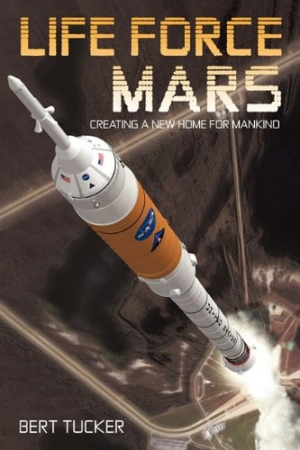Life Force Mars
Creating a New Home for Mankind
Bert Tucker’s ambitions are obvious from the first pages of Life Force Mars: Creating a New Home for Mankind, a book that, in the author’s own words, “is not just a real science fictional story—it’s an illustration of how we could … actually begin sending humans to live on another planet today.” Part novel, part call to arms for would-be space colonizers, and part how-to manual, this celestial juggling act only achieves measurable success in keeping its balls in the air (or orbit, as the case may be).
Tucker, a former pilot, engineer, and author of two other science fiction novels, clearly has an immense level of personal experience with his subject and has done a lot of homework. The book strives to be the hardest of hard science fiction, and his plan—sending four world-class scientists and engineers to start a Mars colony on the presumption that they will never return to earth—is rife with opportunities for drama. It is hard to imagine higher stakes and lower margins for failure than those presented by this scenario.
Admittedly, Tucker pushes toward the fringe of plausibility at some points, especially in the boundless optimism of how his story actually plays out. For instance, the brave explorers will need access to radioactive materials for fuel, and such a supply may or may not be present on their new home planet; conveniently, the material is not only on the red planet but is plentiful. The explorers are, it often seems, on the best of all possible worlds.
The level of technical detail that Tucker achieves is admirablet, making the fictional desert-planet ecology of Dune seem quaint. Yet, this detail—or at least how it is presented—is also the novel’s downfall. The main characters are Tim, Joan, Rob, and Mary. They work for NASA, and they are all interchangeable mouthpieces for the author’s glut of research. They lack even rudimentary characterization and are prone to speaking in blocks of explanation. During a flood, Rob says: “This looks like the enormous catastrophic event that produced the Channeled Scablands in Washington! I expect this will scour everythng—much like a tidal wave. This is worse than a levee breaking on a huge lake because the burden above the water is collapsing into it. The water is surging around us and washing away its base.”
The opportunity that the setting and plot of Life Force Mars offer for conveying intense interpersonal drama, the romance of exploration, and the danger of the unknown is largely lost due to clunky prose. Though Tucker’s fictional Mars colony succeeds, readers with an interest in the actual potential of Mars colonization would be better served digging into the technical literature.
Reviewed by
Kenrick Vezina
Disclosure: This article is not an endorsement, but a review. The publisher of this book provided free copies of the book and paid a small fee to have their book reviewed by a professional reviewer. Foreword Reviews and Clarion Reviews make no guarantee that the publisher will receive a positive review. Foreword Magazine, Inc. is disclosing this in accordance with the Federal Trade Commission’s 16 CFR, Part 255.

